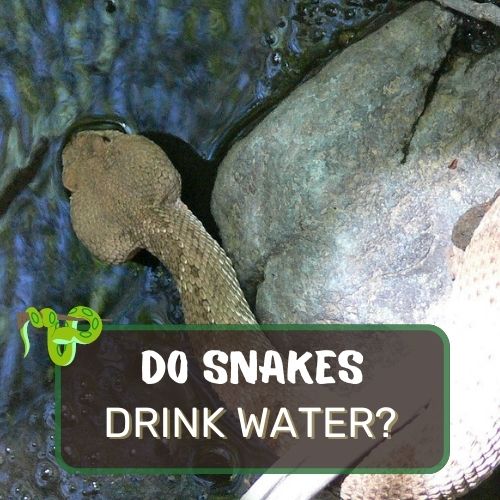
In this article, we will explore the intriguing world of snakes and their relationship with water.
We’ll answer the question “Do snakes drink water?” and delve into the unique and fascinating ways these slithery reptiles obtain and utilize water.
Discover the specialized techniques snakes employ to drink water, using their jaws to create a vacuum and a sponge-like structure to retain hydration.
We will uncover the impact of water availability on snake behavior, how it affects their activity levels, and how they adapt during water scarcity.
Pet snake owners will gain valuable insights on providing water for their scaly companions, understanding its importance for their health and well-being.
Lastly, we will uncover captivating fun facts about snakes and water, showcasing the extraordinary ways these creatures have adapted to survive in diverse environments.
Table of Contents
Answer To Do Snakes Drink Water
Yes, snakes do drink water. However, they have a unique way of obtaining and consuming water. Instead of using their lips or tongues to lap up water like mammals do, snakes use their jaws to create a vacuum and draw in water. They have a specialized sponge-like structure in the roof of their mouths, known as the palatal valve, which helps retain and absorb the water they drink.
Snakes can drink water from various sources, including puddles, bodies of water, rainwater, dew, and even water droplets collected on their bodies. They can also obtain hydration from the water content in their prey during digestion.
Proper hydration is crucial for snakes’ health and well-being, as water is essential for various physiological processes in their bodies.
In captivity, pet snake owners should provide clean and fresh water in a suitable water bowl to ensure their pet’s hydration needs are met.
How Snakes Drink Water

Unique way snakes drink water, using their jaws instead of lips or cheeks
When it comes to quenching their thirst, snakes have an extraordinary approach that sets them apart from other creatures.
Unlike mammals, which often lap up water using their tongues, snakes do not possess lips or cheeks to facilitate drinking. Instead, these slithery reptiles employ their remarkable jaws to get their hydration fix.
Imagine for a moment a snake’s encounter with water. The snake positions its body near the water source, whether it’s a small pool, a droplet, or even dew on leaves.
Then, in a methodical and graceful manner, it opens its mouth wide. By doing so, the snake creates a vacuum that sucks in the water around it.
Specialized sponge-like structures in their mouths
Now, you might wonder how snakes manage to retain the water without it just spilling out of their mouths. Well, nature has equipped these remarkable creatures with a nifty solution – a specialized sponge-like structure.
This unique feature resides in the roof of their mouths, known as the “palatal valve.” Once the snake captures water, this valve acts like a sponge, effectively soaking up the liquid.
This sponge-like structure plays a crucial role in ensuring that the snake doesn’t waste a precious drop of water. It helps maintain the water’s presence inside the snake’s mouth until it can be fully ingested and utilized for hydration.
How snakes capture water with their jaws
To effectively capture water, snakes employ an intriguing technique known as “gaping.” Gaping refers to the act of opening their mouths wide to create the necessary vacuum for drawing in water.
The jaws of snakes are loosely connected, allowing them to expand their mouths significantly, sometimes even to the size of their own body circumference.
The snake’s jaw muscles contract and expand rapidly during this process, making the gaping movement appear almost hypnotic.
As water surrounds the snake’s mouth, the palatal valve comes into play, efficiently absorbing and holding onto the water until the snake has quenched its thirst.
Next time you witness a snake near a water source, take a moment to observe this mesmerizing behavior. You’ll be amazed at the elegance and ingenuity of this unique approach to drinking water.
Water Sources for Snakes

Different sources of water for snakes, including rainwater, dew, and mist
Snakes, like all living beings, require water to survive, but they don’t rely solely on traditional sources like rivers or lakes.
These adaptable creatures have honed their skills at sourcing water from various unconventional sources, such as rainwater, dew, and even mist.
Rainwater offers an abundant and easily accessible water supply for snakes.
After a refreshing rainfall, snakes might venture out of their hiding places to drink from puddles formed on the ground or even from the leaves of plants that have collected raindrops.
How snakes collect water droplets on their bodies and drink them off drop by drop
Snakes have a fascinating ability to gather water droplets on their scales or skin. As they glide through moist areas or vegetation, droplets adhere to their bodies.
When they’re thirsty, they can lick these droplets off drop by drop, using their unique palatal valve to retain and absorb the water efficiently.
This method allows them to stay hydrated even in environments where water sources might be scarce or distant.
How some snakes may also drink water from puddles or bodies of water
In addition to rainwater and dew collection, some snake species are more opportunistic when it comes to hydration. They might actively seek out puddles or bodies of water to drink from directly.
These water sources could be anything from small ponds and streams to temporary rain-filled crevices.
For snakes living in arid regions or during drought periods, finding such water sources might become a crucial task for their survival.
Nonetheless, their adaptive nature and unique drinking mechanisms ensure they can endure challenging conditions.
Remember, when you encounter a snake slithering around, it might not be just exploring its habitat but also on a quest to find that elusive drop of water to quench its thirst.
It’s yet another reminder of the wonders and intricacies of the natural world, where every creature has evolved remarkable strategies to thrive.
Frequency of Water Consumption

How often snakes drink water, which varies depending on factors such as species, habitat, and diet
The frequency of water consumption in snakes can vary widely, influenced by several factors such as species, habitat, and diet.
Snakes living in arid environments, where water is scarce, have evolved to be more efficient in conserving water. They might drink less frequently or obtain water from alternative sources, like the examples we explored earlier.
On the other hand, snakes residing in more humid or water-abundant regions might have access to water sources more frequently, resulting in more regular water intake.
Additionally, the size and age of the snake can also impact its water needs. Larger snakes generally require more water to sustain their bodies compared to smaller ones.
How some snakes may go for extended periods without drinking water
Remarkably, certain snake species have developed the ability to endure extended periods without drinking water directly.
Their bodies have adapted to retain water efficiently, and they can obtain a substantial portion of their hydration from the water content present in their prey.
When snakes consume their prey, they digest not only the food but also the liquid stored within it.
This adaptation proves to be advantageous, especially for snakes that may find it challenging to access water sources regularly.
It allows them to survive and thrive in harsh environments where water might be scarce for extended periods.
How snakes obtain a significant portion of their hydration from the water content in their prey
The diet of a snake plays a significant role in determining its water intake. Snakes are carnivores, and their diet consists mainly of other animals.
Interestingly, many of the animals they consume have a high water content in their bodies, such as insects, amphibians, and small mammals.
As snakes digest their prey, they efficiently absorb the water present in the tissues of their meals. This adaptation helps them maintain their hydration levels without needing to drink water as frequently as other creatures.
It’s a fantastic example of how nature equips different species with unique tools to survive and thrive in their specific ecological niches.
Adaptations for Water Collection

Specialized scales or structures that some snakes have to collect and retain water
In their quest to adapt to diverse environments, some snake species have developed specialized scales or structures that aid in water collection and retention. One such adaptation is the presence of hydrophobic scales.
These scales are designed to repel water, helping the snake to prevent unnecessary water loss.
How these adaptations enable snakes to survive in arid or water-scarce environments
The hydrophobic scales, along with other adaptations, enable snakes to survive in arid or water-scarce environments.
When snakes come into contact with a source of water, these unique scales allow them to efficiently gather and hold onto water droplets on their bodies.
They can then carry these precious droplets with them as they traverse their surroundings, ensuring access to hydration even in the driest of landscapes.
This adaptation is particularly advantageous for desert-dwelling species like the sidewinder rattlesnake, which navigates the scorching sands of the American Southwest.
By optimizing water collection and retention, these snakes can minimize the need for frequent water intake and conserve energy in their search for sustenance.
Examples of snake species with such adaptations
Several snake species showcase these remarkable adaptations for water collection. The Namib Desert’s sidewinder rattlesnake (Crotalus cerastes) is one such example.
This snake’s distinctive sidewinding locomotion helps it move effortlessly across loose desert sands while minimizing contact with the scorching ground.
Additionally, some arboreal snake species, like the green tree python (Morelia viridis), have evolved to absorb water efficiently from raindrops and dew on leaves.
Their scales aid in water retention, ensuring they make the most of any available water sources in their treetop habitats.
These adaptations demonstrate the incredible diversity of snakes and how they have tailored their physiology to thrive in various ecological settings.
From the deserts to the rainforests, snakes continue to amaze us with their ability to conquer and adapt to the challenges posed by their environments.
Impact of Water on Snake Behavior

How water availability affects snake behavior and activity levels
Water availability plays a crucial role in shaping snake behavior and activity levels. When water sources are abundant, snakes tend to be more active and mobile.
They may explore larger territories in search of food, mates, or suitable nesting sites. The presence of water also facilitates their movements, making it easier for them to traverse their environment.
How snakes may be more active and mobile during periods of water abundance
During periods of water abundance, snakes can take advantage of the resources and opportunities available to them. They might engage in more frequent hunting expeditions, increasing their chances of encountering prey.
Additionally, the improved hydration contributes to their overall well-being, enhancing their energy levels and vitality.
Furthermore, water-rich environments often attract other wildlife, creating a thriving ecosystem. As a result, snakes may encounter a higher density of potential prey and predators, leading to increased activity and vigilance.
How water scarcity may lead to changes in snake behavior, such as seeking out water sources or entering a state of torpor
Conversely, when water becomes scarce, snakes must adapt their behavior to survive in such challenging conditions.
They may actively seek out water sources, becoming more focused on finding areas with even the smallest water reservoirs.
In extreme cases of water scarcity, some snake species may enter a state of torpor. Torpor is a form of reduced activity or hibernation that helps them conserve energy during periods of water and food scarcity.
By entering torpor, snakes can reduce their metabolic rate and sustain themselves with minimal resources until more favorable conditions return.
These behavioral adaptations showcase the remarkable resilience and resourcefulness of snakes in coping with fluctuations in water availability, a vital aspect of their survival strategy.
Hydration and Snake Health
The importance of proper hydration for snake health and well-being
Proper hydration is fundamental to the health and well-being of snakes, just as it is for all living beings.
Water is essential for various physiological processes in their bodies, including digestion, temperature regulation, and waste elimination. Adequate hydration ensures that their organs function optimally, supporting overall health.
The potential consequences of dehydration in snakes, such as decreased immune function and organ damage
Dehydration can have severe consequences for snakes, potentially leading to decreased immune function and organ damage.
When snakes lack sufficient water, their bodies struggle to maintain an appropriate balance of bodily fluids. As a result, their immune system may weaken, making them more susceptible to infections and diseases.
Furthermore, prolonged dehydration can lead to organ damage, affecting their kidneys, liver, and other vital organs. In extreme cases, this could be life-threatening.
How water intake may vary depending on factors like snake age, size, and overall health
The water intake of snakes can vary significantly based on various factors, such as age, size, and overall health. Juvenile snakes, for instance, might require more water relative to their body size compared to adult snakes.
Similarly, larger snakes might need to drink more to sustain their larger bodies and metabolic demands.
The health status of a snake also influences its water intake. If a snake is unwell or recovering from an injury, it may drink more to aid in its recovery and healing process.
Ultimately, snakes have a finely tuned mechanism for regulating their water intake, ensuring they strike a balance suitable for their specific needs.
Understanding the relationship between water and snake behavior, as well as its impact on their health, provides us with valuable insights into the intricate lives of these remarkable reptiles.
As we continue to explore and appreciate the wonders of the natural world, let us marvel at the extraordinary adaptations that allow snakes to thrive in their diverse habitats, ever intertwined with the element of water.
Providing Water for Pet Snakes

How to provide water for pet snakes in captivity, including the use of water bowls or misting
If you are a proud owner of a pet snake, ensuring they have access to clean and fresh water is of utmost importance. The most common method of providing water for pet snakes is by using a water bowl.
Choose a sturdy and appropriately sized bowl that your snake can easily access without tipping it over. Make sure to clean the water bowl regularly to prevent bacterial growth and maintain its freshness.
For certain snake species that enjoy higher humidity levels, misting the enclosure can be beneficial.
Misting helps create a humid environment, and some snakes might drink water droplets from leaves or surfaces in their enclosure. However, be cautious not to over-mist, as excessive moisture can lead to health issues and mold growth.
The importance of maintaining clean and fresh water for pet snakes
Just like for any pet, providing clean and fresh water is crucial for the health and well-being of pet snakes. Stagnant or dirty water can harbor harmful bacteria and pathogens, potentially leading to infections or other health problems for your snake.
Regularly replace the water in the bowl and clean it thoroughly to ensure a safe and hygienic water source for your scaly companion.
Tips on monitoring a pet snake’s water intake and recognizing signs of dehydration
Monitoring your pet snake’s water intake is essential, as it can give you valuable insights into their health. Familiarize yourself with your snake’s typical drinking habits and take note of any significant changes.
If you notice a sudden decrease in water intake, it could be a sign of an underlying health issue.
Signs of dehydration in snakes include sunken eyes, wrinkled skin, and lethargy. If you suspect your snake is dehydrated, consult a veterinarian with experience in reptile care promptly.
Early detection and proper care are vital in ensuring your pet snake remains healthy and hydrated.
Fun Facts about Snakes and Water
Collection of interesting and lesser-known facts about snakes and their relationship with water
- Some snake species are excellent swimmers and can move efficiently through water. For instance, the Asian water snake (Enhydris enhydris) is highly adapted to an aquatic lifestyle and can even stay submerged for up to 30 minutes.
- The green anaconda (Eunectes murinus) holds the record for being the heaviest snake in the world. Found in South America, this massive serpent is often associated with water, as it primarily inhabits swamps, marshes, and slow-moving rivers.
- The coastal taipan (Oxyuranus scutellatus) is known as one of the most venomous snakes in the world. Despite its lethal reputation, this snake will often flee from potential threats and rarely confronts humans.
The banded sea krait (Laticauda colubrina) is a fascinating venomous snake that spends much of its life in the ocean. It can travel vast distances from one island to another, using its powerful swimming skills and ability to drink seawater by filtering it through specialized glands.
Snake adaptations for survival in water-scarce environments
- Some desert-dwelling snakes, like the sidewinder rattlesnake, have developed the ability to move sidewinding across hot sand to reduce the amount of contact with the scorching surface, conserving water and energy in the process.
- Certain snake species can survive for extended periods without water by going into a state of torpor, significantly reducing their metabolic rate and water needs until better conditions arise.
These fun facts shed light on the diverse and awe-inspiring world of snakes, highlighting their unique relationship with water and the astonishing ways they have adapted to thrive in various environments.
FAQ
How often do snakes drink water?
The frequency of water intake in snakes varies depending on factors such as species, size, and habitat conditions. Some snakes might drink water daily if they have easy access to a water source, while others, especially those in arid environments, may go for extended periods without drinking water directly. Snakes are adept at conserving water and can obtain hydration from the water content in their prey.
How do you give a snake water?
Providing water for pet snakes in captivity is essential for their well-being. You can offer water to your pet snake by placing a clean and appropriately-sized water bowl inside their enclosure. Make sure to clean and refill the water bowl regularly to maintain its freshness and cleanliness.
Do snakes drink from a water bowl?
Yes, many pet snakes will readily drink from a water bowl provided in their enclosure. Water bowls offer a convenient and accessible source of hydration for snakes in captivity.
Why do snakes sit in water?
Some snake species might be observed sitting or soaking in water occasionally. This behavior is believed to help with shedding their skin. The moisture softens the old skin, making it easier for the snake to shed it off in a process called ecdysis. Additionally, some snakes, like the banded sea krait, have an aquatic lifestyle and spend much of their time in water for hunting and shelter.
Conclusion
In conclusion, the relationship between snakes and water is a fascinating aspect of their biology and behavior. Snakes have evolved unique and ingenious ways to obtain and utilize water, enabling them to thrive in diverse habitats worldwide.
We’ve explored the remarkable ways snakes drink water, using their jaws to create a vacuum and a specialized palatal valve to retain water efficiently.
Additionally, we’ve learned about their adaptive behavior in response to water availability, including entering states of torpor during water scarcity.
For pet snake owners, providing clean and fresh water is vital for their well-being. By monitoring their water intake and recognizing signs of dehydration, we can ensure their health and happiness.
Throughout this journey, we’ve discovered the vital role water plays in snakes’ survival and how it influences their behavior and physiology.
As we continue to marvel at the wonders of the natural world, let us cherish the incredible adaptations that have allowed snakes to conquer and thrive in their ever-changing environments.




0 Comments